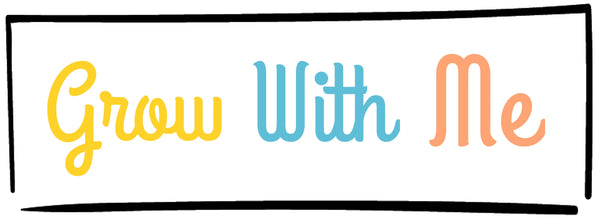
Top 8 Activities for 18 Month Old Toddlers in 2025
Share
Welcome to the bustling world of an 18-month-old! This is a magical age where curiosity is boundless and every day brings new discoveries. Your toddler is now walking, exploring, and beginning to understand the world in more complex ways. Providing the right activities is key to nurturing this rapid development, turning their natural curiosity into foundational learning.
This guide moves beyond generic advice to offer a curated list of specific, developmentally-rich activities for 18 month old toddlers. Each idea is designed to be engaging, easy to set up, and packed with learning opportunities that support crucial cognitive, motor, and sensory skills. We have organised these activities to give you actionable insights you can implement straight away.
Throughout this list, we'll also explore how thoughtfully designed toys, like those in the Grow With Me subscription kits, can elevate this playtime. These toys are crafted to turn simple fun into powerful moments of growth and connection. Let's dive into creating meaningful play that captivates your little one and supports their incredible journey of discovery.
1. Sensory Bins and Exploration
Sensory bins are a fantastic, hands-on activity for an 18-month-old, offering a dedicated space for them to explore different materials and textures. At this age, toddlers learn best by doing, and these bins provide a rich, multi-sensory experience that supports cognitive development, fine motor skills, and even early scientific thinking as they scoop, pour, and mix.
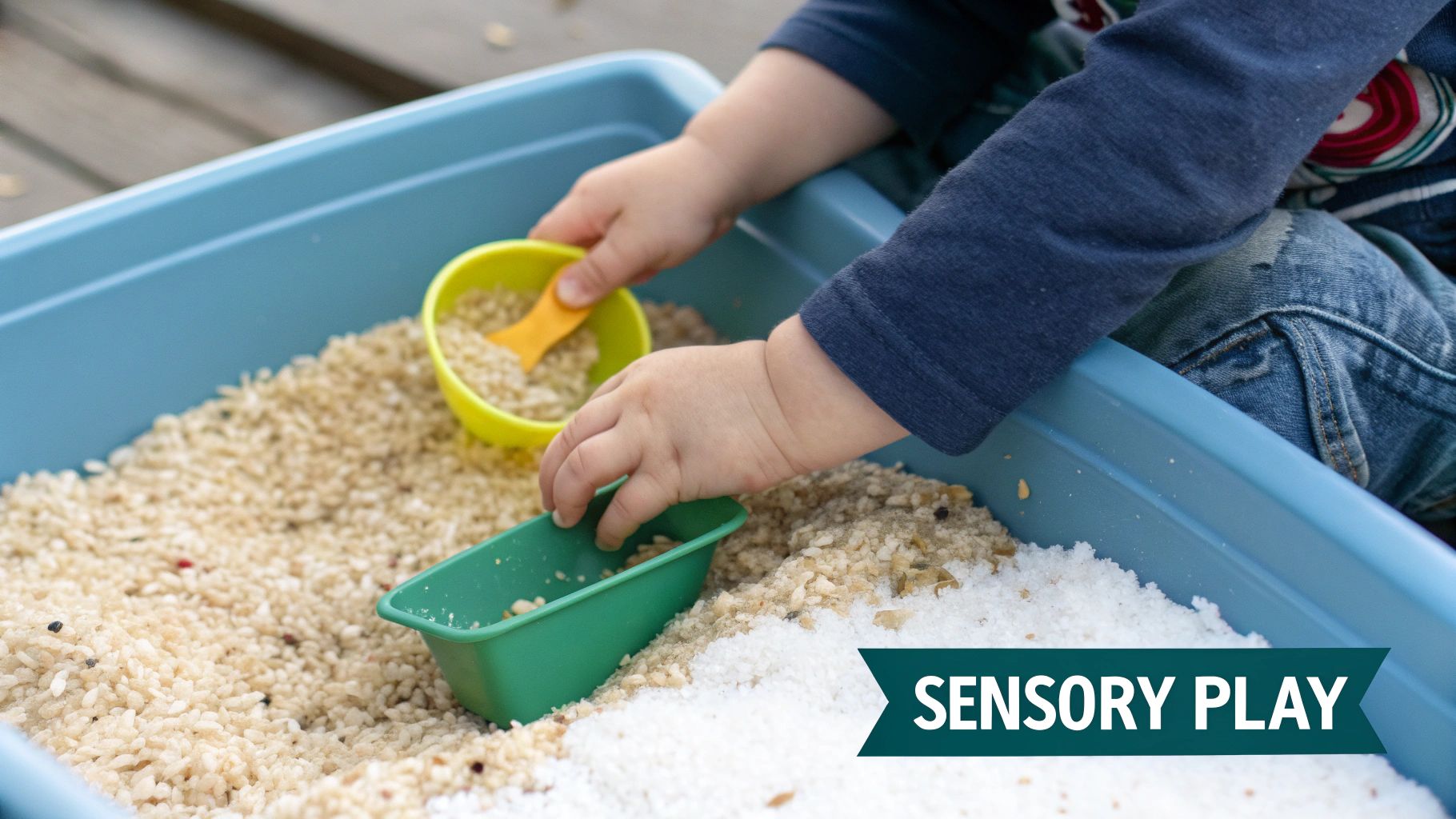
This kind of play helps build crucial neural connections in your toddler's brain. By engaging their senses of touch, sight, sound, and sometimes smell, you are providing a powerful learning foundation. Exploring different textures is also a great way to introduce new vocabulary like "soft," "grainy," or "cold."
Getting Started with Sensory Bins
Setting up a sensory bin is simple. You just need a shallow container, a filler material, and a few tools like scoops or cups. The key is to choose taste-safe and age-appropriate materials, as toddlers this age still tend to explore with their mouths.
- Dry Pasta & Scoops: A classic choice. Use different shapes of dried pasta with spoons, cups, and funnels to practise pouring and transferring.
- Water & Floating Toys: A small tub of water on a warm day is perfect. Add floating toys, sponges, and small jugs for endless splashing and scooping fun.
- Cloud Dough: Mix 8 parts plain flour to 1 part vegetable oil for a silky, mouldable dough that's completely taste-safe and wonderfully tactile.
- Edible Sand: Blended Cheerios or other plain cereals make a great alternative to sand and are perfect for indoor play with toy diggers and trucks.
Top Tip: Always supervise sensory play closely. Keep initial sessions short, around 10-15 minutes, to match your toddler's attention span and prevent them from becoming overwhelmed.
By offering these simple yet engaging activities for your 18-month-old, you're not just keeping them busy; you're nurturing their curiosity and developmental growth in a meaningful way. You can learn more about the benefits of a sensory-rich environment with these sensory toys for babies and how they support early learning.
2. Simple Obstacle Courses
Creating a simple obstacle course is a brilliant way to channel your 18-month-old's boundless energy into purposeful play. At this age, toddlers are mastering crucial gross motor skills like walking, climbing, and balancing. An indoor or outdoor course challenges these developing abilities in a fun, safe environment, building their physical confidence, problem-solving skills, and spatial awareness.
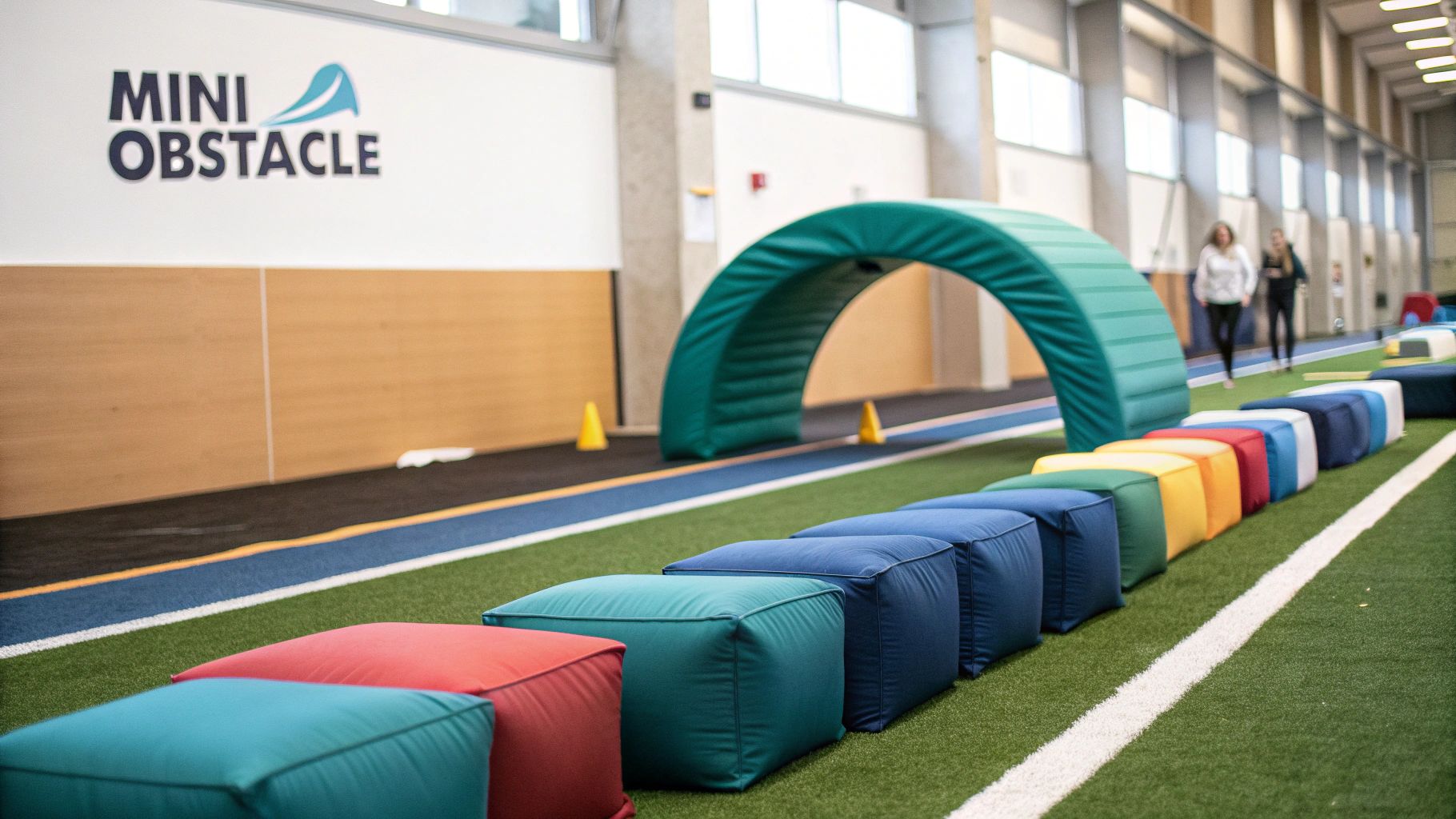
This type of active play is essential for strengthening muscles, improving coordination, and helping your toddler understand how their body moves in space. By navigating different challenges, they learn concepts like 'over', 'under', and 'through', which boosts both their physical and cognitive development. It’s one of the most dynamic activities for an 18-month-old that can be adapted for any space.
Getting Started with Obstacle Courses
You don’t need special equipment to build a fantastic obstacle course; everyday household items work perfectly. The goal is to create a series of simple, safe challenges that encourage movement and exploration. Always ensure the area is clear of hazards and that any furniture used is stable.
- Pillow Path: Arrange cushions and pillows on the floor for your toddler to step or crawl over, challenging their balance.
- Cardboard Box Tunnel: Open up both ends of a large cardboard box to create an exciting tunnel to crawl through.
- Tape Balance Beam: Use painter's tape to create a straight or zig-zag line on the floor for your toddler to walk along.
- Laundry Basket Push: Place a toy in a laundry basket and encourage your toddler to push it from one point to another.
Top Tip: Start with just two or three simple stations to avoid overwhelming your toddler. Demonstrate how to complete each task with enthusiasm and narrate the actions ("Now, we crawl through the tunnel!") to build their vocabulary and understanding.
3. Water Play Activities
Water play is a universally loved activity for an 18-month-old, offering a simple yet profound way to engage their senses and curiosity. Whether in a bathtub, a small basin, or a dedicated water table, the simple act of splashing, pouring, and scooping is captivating. This type of play is foundational for learning early science concepts like cause-and-effect (what happens when I splash?), volume, and gravity.
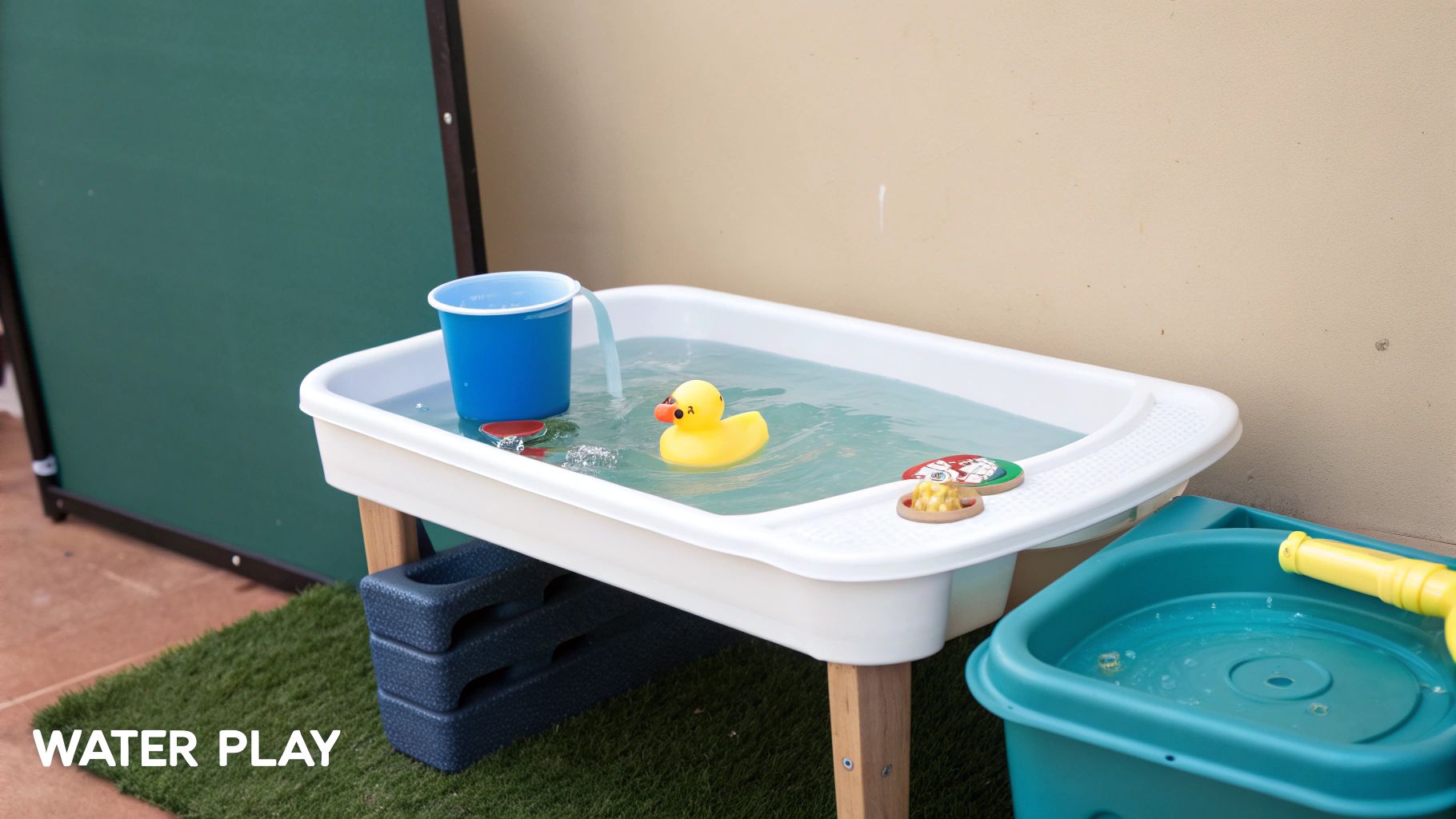
Engaging with water helps to develop fine and gross motor skills, enhances hand-eye coordination, and can have a wonderfully calming and regulating effect on a busy toddler. It provides a rich sensory experience that is both fun and educational, allowing them to experiment and discover at their own pace in a low-pressure environment.
Getting Started with Water Play
Setting up for water play can be as simple or as elaborate as you like. The key is creating a safe space for exploration. Even a small washing-up bowl on the floor with a towel underneath can provide hours of entertainment and learning.
- Toy Washing Station: Fill a small basin with bubbly, lukewarm water and provide some plastic animals or toy cars along with a sponge or cloth to "wash" them.
- Pouring & Transferring: Offer a collection of different-sized plastic jugs, cups, and funnels. Your toddler will be fascinated by watching the water move from one container to another.
- Painting with Water: On a warm day, head outside with a pot of water and some large paintbrushes. Let your little one "paint" the fence, patio, or walls and watch the marks magically disappear as they dry.
- Bath Time Fun: Enhance bath time with measuring cups, squeeze toys, and water wheels to turn a daily routine into a powerful learning opportunity.
Top Tip: Safety is paramount. Never leave a child unattended around water, no matter how shallow. Always stay within arm's reach and ensure the play area is on a non-slip surface.
Water-based activities for an 18-month-old are incredibly versatile and require minimal preparation for maximum developmental benefit. It’s a fantastic way to support their cognitive growth and motor skills while they simply have fun.
4. Art and Creative Expression Activities
Engaging in art and creative expression offers your 18-month-old a powerful way to explore their world and communicate their ideas long before they have the words to do so. At this age, the focus is entirely on the process, not the final product. These activities for an 18-month-old are fantastic for developing hand strength, the pincer grasp, and understanding cause-and-effect as they make their first marks.
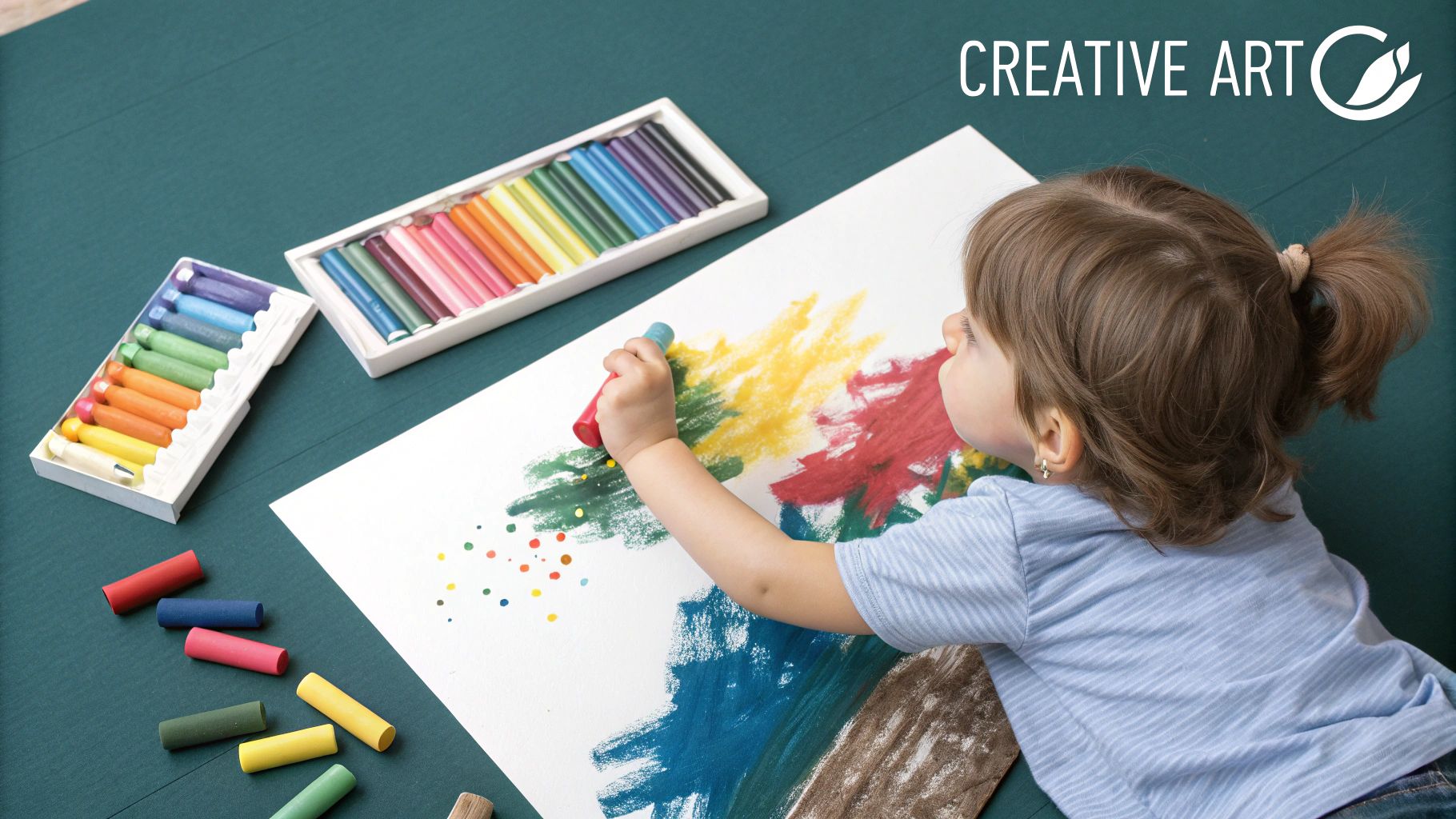
This kind of open-ended play is a cornerstone of philosophies like the Reggio Emilia approach, which views the child as a capable creator. By providing simple, non-toxic materials, you give them the tools to experiment with colour and texture, which builds confidence and supports sensory development. It's a joyful, and often messy, way to nurture their budding creativity.
Getting Started with Creative Expression
The key to successful art time is preparation and embracing the mess. Use washable, child-safe materials and set up in an easy-to-clean area. Taping a large sheet of paper to their high-chair tray or the floor gives them a stable canvas to work on.
- Finger Painting: Use edible, non-toxic finger paints on a large piece of paper. This is a brilliant sensory experience, allowing them to feel the texture of the paint as they create.
- Jumbo Crayons: Chunky, easy-to-grip crayons are perfect for little hands learning to make marks. They help build the foundational muscles needed for writing later on.
- Sticker Fun: Peeling and placing large stickers onto paper is an excellent fine motor workout that strengthens their pincer grasp and improves hand-eye coordination.
- Water Painting: For mess-free fun, give your toddler a pot of water and a paintbrush to "paint" on coloured construction paper, a fence, or the pavement outdoors.
Top Tip: Keep creative sessions short and sweet, following your toddler's lead. Praise their effort and exploration rather than the final look of their artwork. Dress them in old clothes so you can both relax and enjoy the process without worrying about stains.
5. Music and Movement Activities
Interactive music and movement sessions are wonderful activities for an 18-month-old, channelling their natural energy and love for rhythm into purposeful play. At this age, toddlers are becoming more coordinated and are fascinated by cause and effect, making simple instruments and action songs incredibly engaging. This type of play is a powerhouse for development, simultaneously boosting gross motor skills, listening abilities, and language acquisition.
Combining sound with physical action helps your toddler build crucial brain connections, improving their memory and ability to follow simple instructions. Singing action songs like 'The Wheels on the Bus' introduces new vocabulary in a fun, repetitive context, while dancing to different tempos helps them develop a sense of rhythm and physical self-awareness.
Getting Started with Music and Movement
You don't need to be a musician to bring musical play into your day. All you need is some music, a bit of space, and an enthusiastic attitude. The goal is joyful participation, not perfect performance.
- Action Songs & Rhymes: Sing classics like 'If You're Happy and You Know It' or 'Head, Shoulders, Knees and Toes', performing the actions together to reinforce word meanings.
- Simple Instruments: Provide age-appropriate instruments like shakers, a small drum, or a colourful xylophone. Even pots and wooden spoons make fantastic percussion instruments.
- Freeze Dance: Play an upbeat song and dance around wildly. When the music stops, everyone freezes in place. This simple game is brilliant for developing listening skills and impulse control.
- Animal Movements: Put on a song and pretend to move like different animals. Stomp like an elephant, hop like a bunny, or slither like a snake to encourage creative expression and gross motor development.
Top Tip: Create a varied playlist with upbeat dancing songs, calming classical pieces, and tunes from different cultures. Using scarves or ribbons as props can add a wonderful visual and sensory element to your dance sessions.
6. Building and Stacking Activities
Building and stacking are classic activities for an 18-month-old that are foundational for developing crucial skills. This simple act of placing one object on top of another builds hand-eye coordination, fine motor control, and an early understanding of spatial relationships and physics. For a toddler, constructing a tower and then knocking it down is a powerful lesson in cause and effect.
This type of construction play strengthens problem-solving skills as your toddler figures out how to balance objects to make their tower taller. It also introduces important concepts and vocabulary like "on top," "under," "big," and "small." Whether they are carefully placing blocks or gleefully watching them tumble, they are actively experimenting and learning about their world.
Getting Started with Building and Stacking
You don't need fancy equipment to get started; many household items work perfectly. The goal is to provide safe, appropriately sized objects that your toddler can manipulate, stack, and explore.
- Classic Wooden Blocks: A set of simple wooden blocks is incredibly versatile for building towers, walls, or whatever your toddler imagines.
- Nesting & Stacking Cups: These are fantastic for learning about size and order. Your toddler can practise stacking them up high or nesting them inside one another.
- Large Interlocking Blocks: Blocks like LEGO DUPLO or Mega Bloks introduce the concept of connecting pieces, adding a new dimension to construction play.
- Household Containers: A collection of clean plastic food containers or empty boxes provides a great, low-cost option for stacking and sorting by size.
Top Tip: Celebrate the entire process, including the inevitable crash! Knocking things down is just as important for learning as building them up. Model simple language during play, saying things like "Up, up, up... and down!" to connect words with actions.
By encouraging these simple yet effective activities for your 18-month-old, you are supporting their cognitive and physical development. To discover more toys that support these skills, you can find some of the best educational toys for an 18-month-old that will grow with your child.
7. Reading and Book Exploration
Reading with your 18-month-old is a powerful activity that lays the foundation for language development, literacy, and a lifelong love of books. At this age, toddlers are like sponges for new words, and sharing a book introduces them to new vocabulary, sentence structures, and the concept that pictures represent real-world objects. It’s a quiet, connecting activity that supports their rapidly expanding cognitive abilities.
This shared experience strengthens the parent-child bond and helps build your toddler’s attention span. Engaging with interactive books, pointing at pictures, and hearing your voice bring a story to life creates positive, warm associations with reading that will benefit them for years to come. It's one of the most effective activities for an 18-month-old to boost early communication skills.
Getting Started with Book Exploration
Creating a positive reading experience is more about interaction than finishing a story. Focus on making it fun and following your child’s lead, allowing them to touch the pages, point, and babble along with the story.
- Interactive Books: Choose sturdy board books with engaging features. Lift-the-flap books like the 'Where's Spot?' series build anticipation, while touch-and-feel books like Usborne's 'That's Not My...' series provide valuable sensory input.
- Repetitive Stories: Books with rhythmic, predictable text like 'Brown Bear, Brown Bear, What Do You See?' are fantastic. Encourage your toddler to join in with animal sounds or repeated phrases.
- Photo Albums: Create a simple photo book of family members, pets, and familiar places. Naming people and objects they recognise makes the experience personal and highly engaging.
- Accessible Book Nook: Keep a small selection of books in a low basket or on a low shelf where your toddler can access them independently.
Top Tip: Don't worry if your toddler wants to flip pages quickly or doesn't sit for the whole story. The goal is positive exposure. Let them lead the way, even if it means reading the same favourite book ten times in a row.
By making books a regular part of your day, you provide a rich learning environment that nurtures their curiosity and language skills. You can discover more options by exploring some of the best board books for babies and how they support key developmental milestones.
8. Pretend Play and Imitation Activities
Pretend play is where your 18-month-old's imagination truly begins to flourish, as they start to imitate the world around them. This type of play is a huge developmental leap, marking their ability to understand that one object can symbolise another- a block becomes a phone, or a bowl becomes a hat. These early imaginative activities for an 18-month-old are fundamental for developing social-emotional skills, language, and problem-solving abilities.
Engaging in imitation helps toddlers process their daily experiences and understand social roles. When they "feed" a doll or "talk" on a toy phone, they are practising empathy, communication, and making sense of adult actions. This play is a safe space for them to explore emotions and test out different scenarios, building a foundation for more complex imaginative play later on.
Getting Started with Pretend Play
You don't need elaborate toys to encourage imitation; simple props and your own modelling are the most powerful tools. The key is to provide open-ended items that can be used in many different ways and to join in on their play.
- Caring for a "Baby": Provide a soft doll or a favourite stuffed animal with a small blanket and an empty bottle. Show them how to gently rock the baby, tuck it into bed, or pretend to feed it.
- Toy Kitchen Fun: Use a toy kitchen or simply a few plastic bowls, wooden spoons, and empty food boxes. Pretend to cook a meal together, stir the "soup," and serve it to other toys.
- "Cleaning" House: Toddlers love to copy household chores. A toy broom, a small dustpan, or even just a soft cloth for "dusting" can provide hours of purposeful play.
- Playing Doctor: A simple toy medical kit allows your toddler to care for their teddies. They can listen to a heartbeat with a toy stethoscope or put a plaster on a sore knee.
Top Tip: Narrate your child’s actions to build their vocabulary and reinforce their ideas. Saying things like, "You're giving teddy a big hug!" or "Are you cooking some yummy pasta?" helps them connect words to their play.
By creating opportunities for pretend play, you are nurturing your toddler's creativity and helping them understand their world. These simple yet profound activities for an 18-month-old are crucial for their cognitive and emotional growth.
8-Activity Comparison Guide for 18-Month-Olds
| Activity | Implementation Complexity 🔄 | Resource Requirements ⚡ | Expected Outcomes 📊 | Ideal Use Cases 💡 | Key Advantages ⭐ |
|---|---|---|---|---|---|
| Sensory Bins and Exploration | Moderate (prep and supervision) 🔄 | Low-cost, common or specialized items ⚡ | Supports sensory processing, fine motor skills, cognitive development 📊 | Independent or guided play for 15-30 mins 💡 | Enhances fine motor skills, calming effect, language development ⭐ |
| Simple Obstacle Courses | Low to Moderate (setup and safety) 🔄 | Very low-cost household items ⚡ | Builds gross motor skills, coordination, confidence 📊 | Indoor/outdoor physical activity, energy release 💡 | Strengthens large muscles, problem-solving, confidence ⭐ |
| Water Play Activities | Low to Moderate (setup and supervision) 🔄 | Minimal materials needed ⚡ | Fine motor control, sensory integration, early science concepts 📊 | Sensory play, hot weather, cause-effect learning 💡 | Highly engaging, therapeutic, teaches scientific concepts ⭐ |
| Art and Creative Expression | Moderate (prep and cleanup) 🔄 | Supplies vary, some can be costly ⚡ | Develops fine motor skills, creativity, early mark-making 📊 | Short creative sessions, sensory exploration 💡 | Encourages creativity, hand strength, color recognition ⭐ |
| Music and Movement Activities | Low (minimal setup, requires participation) 🔄 | None to low (instruments optional) ⚡ | Language acquisition, motor coordination, emotional expression 📊 | Anytime/anywhere, mood regulation, social skills 💡 | Boosts language, coordination, emotional regulation ⭐ |
| Building and Stacking Activities | Low to Moderate (organizing materials) 🔄 | Durable blocks or household items ⚡ | Spatial awareness, problem-solving, fine motor precision 📊 | Independent or cooperative play 💡 | Develops spatial reasoning, creativity, persistence ⭐ |
| Reading and Book Exploration | Very Low (requires only books) 🔄 | Board and interactive books, low cost ⚡ | Vocabulary growth, literacy foundation, attention span 📊 | Quiet time, routines, language development 💡 | Builds language and literacy skills, strengthens bonding ⭐ |
| Pretend Play and Imitation | Low to Moderate (some adult modeling) 🔄 | Toy sets or household props ⚡ | Social-emotional growth, symbolic thinking, language 📊 | Role-play, social skills, emotional processing 💡 | Enhances empathy, creativity, language, and emotional skills ⭐ |
Nurturing Growth Through Everyday Play
The journey with your 18-month-old is a whirlwind of discovery, and the activities we've explored are more than just ways to pass the time; they are the building blocks of early development. From the focused calm of a sensory bin to the joyful chaos of an indoor obstacle course, each moment of shared play is a powerful opportunity for learning, bonding, and growth. These hands-on experiences are precisely how your toddler makes sense of the world around them.
The most crucial takeaway is that the "best" activities for an 18 month old are those that are engaging, flexible, and responsive to your child's unique pace and interests. There is no need for perfection or elaborate setups. A simple box can become a car, and a few cushions can become a mountain to climb. The magic lies in the participation, the shared smiles, and the celebration of every small effort and newly acquired skill.
Your Path Forward: Embracing Purposeful Play
As you move forward, remember to observe and follow your toddler's lead. Their curiosity is the best guide you have. If they are fascinated by pouring and scooping, lean into water play and sensory activities. If they are constantly climbing, create safe and simple obstacle courses to challenge their gross motor skills.
Here are a few actionable steps to integrate these ideas seamlessly:
- Rotate Activities: Keep things fresh by rotating toys and activities every week. This prevents overstimulation and renews your child's interest in their playthings.
- Prepare in Advance: Spend ten minutes in the evening setting up a simple activity for the next day. Having a prepared art station or a ready-to-go sensory bin can transform a potentially challenging morning.
- Embrace the "Helper" Stage: Involve your toddler in simple household tasks like putting away laundry or "washing" vegetables. This imitation is a vital form of pretend play and builds their sense of competence and belonging.
By consciously weaving these purposeful activities for your 18 month old into your daily rhythm, you are not just entertaining them. You are actively nurturing their cognitive abilities, refining their motor skills, and strengthening the secure emotional bond that will serve as their foundation for a lifetime of confident learning and exploration. Every splash, every scribble, and every stacked block is a step forward on this incredible developmental journey.
Ready to take the guesswork out of developmental play? Discover how the expertly curated play kits from Grow With Me can perfectly complement these activities, delivering stage-appropriate, high-quality toys and guidance right to your door. Explore the subscription and support your 18-month-old's learning journey today at Grow With Me.
